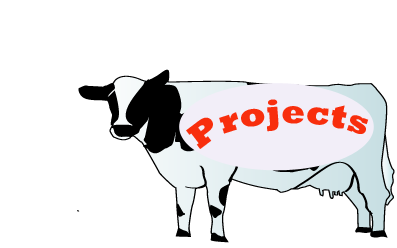

Chapter 1
Even in the gloom of a late afternoon in February, the many fruits and vegetables in Milk Pail glowed like a psychedelic ocean under the righteously out of season twinkle of Christmas lights. Over at one side of the store, the cheese room was awash in a surreal white light while the rows of fridges played out like a U.N. conference of cheese and sausages. Although a tad claustrophobic by nature, the market is especially crowded at the moment, considering that it is around 5 pm on a Sunday. As I mingle throughout the store, I am serenaded, not by the sounds of muzak but the chatter of what truly feels like a crowded marketplace.
While browsing through the store, it soon becomes clear that it is quite a unique venue. Especially in today’s economic climate: There is only one milk pail, and its total area does not take up more space than a McDonalds (though a remodeling project is soon to be underway.) So how does the Milk Pail keep attracting customers? Such a crowd is especially odd considering that the milk pail has ceased advertising a good few years ago. Therefore most people are either visiting off of personal experience or word of mouth.
It seems fairly obvious why someone might buy his or her groceries at somewhere Safeway. There are locations every few miles across the country, there are adds on TV, coupons in the newspaper, and the stores are stocked with familiar brands of food that people recognize and are fairly comfortable with. Safeway, which is currently the world’s largest chain of food retail stores started out as a chain of stores in 1914 with a major popularity boost in the fifties. Around that time the Safeway franchise fell into the hands of Robert A. Magowan after the previous owner Lingan A. Warren’s game of low-price chicken with competitors yielded inadequate profits as far as the stockholders were concerned. Magowan reversed the low pricing decentralized Safeway’s operations and bought out other stores. Conversely, The Milk Pail started out as The Milk Pail Dairy after current owner Steve Ramussen bought the recently defunct Brentwood Farms Dairy in 1973. Unlike Safeway however, The Milk Pail Doesn’t seem to be out for world conquest. The one Milk Pail location is the same one from 1973 and is currently maxed out on customers. “For now, we’d much rather just upgrade and take care of, to the best of our abilities, the customers that we already have.” Says one Milk Pail Employee, “A lot of stores start off with a certain vision and just are not able to change that vision to keep up with the times. This is a good example. We’re not even doing what we started off doing 30 years ago.”
Unlike many stores, the milk pail is an ever changing market based directly off of customer requests “lots of times customers would say ‘Can you get thus and such for us?’” says Steve, “And we would, but we’ve never had a lot of space so we’d figure out how to create more space and then we’d have more shelving and we’d put more things in those shelves.” As a result of this process, The Milk Pail contains no Kraft-esque brands, but does contain an eclectic assortment of foods requested from around the world. Because of this, Steve often refers to his customers as “thrill seekers. ”
But who are the thrill seekers? What is it that might drive people to put aside what they are familiar with and spend money on things that they’ve never heard of? Even with similar products, why might some people buy those products from store “A” and others from store “B?”
Chapter 2
This interview with Steve was one that lasted a good while and proved to be very insightful. I learned a lot about the nature of small business and how their customers admire the sense of community that small businesses promote. Finally, as I was about to leave, he recommended two books: Going Local and The Small Mart Revolution by Michael H. Schuman. Being as thick as I am, I then asked if I could find it off of amazon.com and immediately destroyed all creditability for my own argument.
Steve then, with more patience then most with similar beliefs would have, directed me towards Kepler’s bookstore in Menlo Park. While visiting there, I sought to buy The Small Mart Revolution and a book by Italio Calvino I eventually found both and after curiously flipping through a few pages of Nick Cave’s And the Ass Saw the Angel, I began my exodus toward the checkout line. It is here that I discovered the true meaning of the bookstore. Clark Kepler, owner of Kepler’s described the true bookstore employee as someone who "loved books and didn't want to have a real job." Although the real job part might be up for debate, someone who really loved books in fact, sold my books. The Small mart Revolution got scanned and priced with the air of almost every other book being sold. But when the clerk in question scanned the copy of If on a Winter’s Night a Traveler by Italo Calvino, the clerk and I launched into a small conversation about not only the literary works of Italio Calvino but also the Physical feeling that accompanies prolonged readings of said literary works.
After this conversation, he left the empty checkout to lead me around the bookstore in search of books by Jorges Borges and Lydia Davis. I then paid for my books, and left Kepler’s more satisfied then any other bookstore run I could remember. I was then talking to one of my friends, or was about to, when the mention of Kepler’s met a response that went somewhere along the lines of “dude, aren’t those books really expensive.” Around that time, I also stumbled upon a passage in the introduction to Small Mart Revolution that is quoted as saying that “the ‘savings’ from shopping at chain stores generally turn out to be vastly overestimated,” and then cited an example of a 2002 survey by the Maine Department of Human Services that found that local pharmacists were often cheaper than members of the Walgreen’s pantheon.
So is such an example just an exception to the rule that is capitalism? If there are no consistent bargains that come with buying from big business, then why has that become the norm of thought? Obviously, I sought to resolve the question that is local deals by trying to replicate another example of it. Since I was still somewhat impressed with my trip to Kepler’s that afternoon, I decided to see if such a trend would remain consistent within the realm of books. For this experiment I would find three different books: A Classic (To Kill A Mockingbird by Harper Lee), A Bestseller (The Appeal by John Grisham), and A relatively obscure book (playing off of bias, I chose On A Winter’s Night A Traveler), in Kepler’s, an independent bookstore; Books Inc, a small bookstore chain of three locations; Banes and Noble, a huge bookstore mega chain, amazon.com and Wal-Mart. I’d find the price at every location and compare it to the list price (a.k.a. the one on the back); I’d also take note on the amount of books currently on the shelves as well as the atmosphere of the place I was browsing at.
The results of said experiment are as follows:
To Kill A Mockingbird† :If On A Winter’s Night a Traveler††: The Appeal*
List Price ($) $6.99: $14.00: $27.95
Barnes & Noble ($) $6.99: N/A: $27.95
Barnes & Noble (#) 15: 0: 2
Kepler’s ($) $6.99: $14.00: $27.95
Kepler’s (#) 7: 3: 5
Wal-Mart ($) N/A: N/A: $19.34
Wal-Mart (#) 0: 0: 41
Books Inc. ($) N/A: $27.95
Books Inc. (#) 0: 8
Amazon.com ($) $6.99: $11.20 (-$2.40**): $16.77(-$11.18**)
Amazon.com (w/shipping) $10.98 (+$3.99): $15.19 (+$1.19**): $20.76 (-$7.19**)
†)Grand Central Publishing paperback edition
††)Harvest Books Paperback edition
*)Doubleday Hardback edition
**)Difference from list price
Notes:
Kelper’s: According to an article in the Palo Alto weekly, Kepler’s has a famous history of promoting freethinking and pacifism. Calling it "The Peninsula's largest anti-missile bookstore," Kepler would go as far as putting Chairman Mao's Red Book in the store windows despite disagreement with Mao’s philosophies, because he believed that people should have access to whatever they wanted to read. As a result, Kepler’s was labeled subversive, and endured critical acclaim in the form of arson and death threats.
That being said, the store looks fairly plain. Even through this is not the same location that endured mass semi-violent protest from the far right 50 years ago; it is surprising with today’s current advertising trends that a store with such a radical history wouldn’t capitalize on it at all. The Walls are very plain. On One side there is a magazine rack and a window showing a view of el camino real. On the other side there is a maze of shelves leading you through the books contents. Even the children’s section would be practically interchangeable from the rest of the store if it were not for the books themselves.
Books Inc.
Originally titled “Printer’s Inc.” Books Inc. is a small bay area based chain of about three locations. Although it is not Bamboola, it shows somewhat more zazz then Kepler’s bare-bones approach. It even has it’s own little loft café where you can buy coffee and pastries. The walls contain various book recommendations and, on the loft, menu items that are all written on chalkboard in such a way that can’t help but bring to mind Starbucks. Some Classical Music plays quietly in the background. Yet of all the little perks that books inc. has, the subtlest, yet most influential has to be it’s bizarrely accurate sense of symmetry. On each side of the store, there are bookcases protruding from the walls at roughly the exact same spots, with all of the new releases and staff picks on little tables in the center. Such a technique conveys a vague sense of both tidiness and honesty from the place. Books inc are both too neat to leave books laying around all willy-nilly, and honest enough not to get you lost so that you might stumble upon something else worthy of your pocketbook along the way.
Barnes & Noble:
As opposed to the tiny chain that in Books Inc, Barnes & Noble is a huge chain that spans the entire country. So, as expected, Barnes & Noble has the atmosphere of Books Inc. on steroids. It is about the size of a small warehouse, has its own café, which both proudly and shockingly serves Starbucks coffee. Most importantly, Barnes & Noble took the symmetry of Books Inc to terrifying new levels. Here, if not for the CD and children’s book sections, which are linked to the right half of the store, the outlet in San Jose looks completely identical on both sides. On the walls of Barnes & Noble are posters containing the covers of classic books like one would see with albums in a record store; thus helping to give off the mainstream message that “reading is fun, history says so.”
However, as opposed to the children’s sections of the former two stores, walking through the arch doorway into the children’s section is like walking into another world. Whereas the walls outside were a mundane off white, the children’s section is pastel yellow with a huge, appropriate mural of Alice in wonderland.
Wal-Mart:
Enough Said.
Amazon.com:
Although amazon.com really doesn’t have a store I could loiter at, there is a lot that can be said about its “deals” once shipping comes into play. Although amazon.com’s initial prices deliver more and better deals than most other sources, for 2/3 of the books, you actually ended up paying more than list price. However, you can choose to opt out of shipping charges (in turn for slower shipping) if you buy 25$ or more. A very ingenious strategy in that, when all is said and done, you can get some great deals, but in order to get them you must spend at least 25$ or more. This is effective in that even I have bought more than I needed too in order to access free shipping.
It is interesting that, although there are different levels of glamour in every
Store there is, that for the most part they all revolve around the same price: the list price. So why might people assume that the more mainstream stores are more expensive? Possibly, it has to do with the way the stores are set up. If this were the case, then a major player would be the über-neat organization symmetry that is apparent in Barnes & Noble as well as Books Inc. By doing this they tell you that even the thickest of people can find their books, therefore if you are that important they would be able to cut costs for you. On the other hand, Kepler’s is considerably more difficult to navigate. Combine that with being usually more crowded then the other stores, and it is easy to feel excluded, as even I did at first on that one fateful day. Therefore if one feels that a store is exclusive they might feel that the store is willing to up the prices to prove member loyalty.
Another note of interest is the data for Wal-Mart, who is one of the largest sellers of books in the country, despite the fact that they only have one book one the list: the best seller. However, they also happen to have 41 copies of said book and are the only supplier that actually has a deal from the list price without buying other items. It seems noteworthy to point out that an outlet Wal-Mart’s level can become a major player in the book business as long as they happen to have the best seller at a reasonable price and practically nothing else.
Chapter 3
After directing me to the wonderful world of Kepler’s, Steve then happened to bring up The Hometown Peninsula, which is an alliance of independent businesses on the San Francisco peninsula. Both Kepler’s and The Milk Pail are members. Their mission statement, according to the website is as follows:
Hometown Peninsula’s mission is to support locally owned, independent businesses on the peninsula, to maintain our unique community character, to educate citizens that purchasing locally creates community economic strength, and to bring back the vibrant hometown to our communities that is being displaced by national chains and online stores.
By this claim, one would become under the impression that hometown peninsula are the last freedom fighters against the ten-horned beast of big business. They fight bravely, they fight vigorously, and they fight in the name of community business. The community what they seek to defend, but also where their true business lies: Not even the most cynical advocate of mega-chains can deny the contributions that both to and through their community. Because local businesses are all rooted in the community, they have no back up locations to resort to, hence no risk of packing up and leaving lots of people out of work.
In Fast Food Nation, Eric Schlosser goes in depth on how “The High turnover rates at fast food resturaunts, the part time nature of the job, and the marginal social status of the crew members have made it difficult to organize their workers.” To the extent that a McDonald’s in Quebec was shut down after attempts to thwart a union failed. Likewise, Schlosser goes in mentions how “fast food chains often reward managers who keep their labor costs low, a practice that often leads to abuses.” This is then followed up by stories on how un-unionized workers were sometimes put through a number of abuses such as being paid in food, being made to clean the store on their own time, or being told to stay late for bust shifts and told to leave when business was slow. Other than managers they all received an hourly wage.
The workers at the Milk Pail are not unionized, yet, according to their manager, “at least half of the people who work [T]here have worked here for many, many years.” And “There are a lot of employees here who have worked here for 20.” One can speculate that, unlike McDonalds, the Milk Pail community based status, Steve’s efforts to ” work hard and play hard.” And “give back to the employees”, and the fact that “[they] maxed out on how many customers and volume that [they] can handle,” the Milk Pail’s Main emphasis seems to be more in line with providing to the customer and the community both through good products and reliable jobs. As a result of this, many community customers also feel the need to provide back in the form of repeat business.
Chapter 4
As opposed to the conventional wisdom regarding businesses and price, people tend to assume that goods bought at independent businesses are of better quality. “We don’t have a lot of room,” says one employee “so instead of carrying 30 jams, we try and carry a couple of the best jams you’ve ever, ever tasted. That is our philosophy.” In the grocery department, this could be because independent grocers are often stocked from more local sources. In the interview, Steve describes how “in the summer, what happens is that you have growers out in the central valley who will sell different to business to those who sell enough quantity to make distribution effective. So we’ll have strawberries come to us daily from Watsonville, and they are very popular our strawberries and what happens during October is that we drive our own trucks to half moon bay, over to Pescadero over to buy pumpkins from the grower.”
On the flipside, mass food retail stores have a much bigger reliance on processed food. In America, “about 90 percent of the money that we use to spend on food, we spend on processed food (Fast Food Nation ¶2).” Unfortunately for America, “the dehydrating, freezing, and canning techniques used to process food destroy most of its flavor (“ “)”. To compensate for this lack of actual flavor, there are companies spread throughout the country who are confronted with the task of making flavors for processed food. Fast food Nation then depicts the flavor and fragrance companies such as “International Flavors and Fragrance,” “Haarman and Reimer,” and “Elan Chemical” that synthetically construct chemicals for processed food. Schlosser describes his trip to one of these plants, which eventually ends when he can smell, in detail a hamburger when presented with merely a strip of paper containing a certain chemical compound. So, as a counterbalance to the brand familiarity, maybe people buy local food because they know that what they eat is real.
While still in session with Steve, I brought up yet another daunting food menace: green tomatoes. By now, it has become common knowledge that major grocery stores buy their tomatoes from large farmers while they are still green. This leads too much greater flexibility when distributing said fruits; unfortunately it also guys the flavor of the fruit itself. When I asked about the Milk Pail’s tomato practices he brought up the produce terminal in South San Francisco that distributes produce to many a grocery store and restaurant throughout the bay area. “If you buy them from the terminal” Steve says, “then you and when you re buying in season, there is no greening process you are picking up tomatoes that are ready to be eaten that day because the farmers have already taken care of that.”
Conclusion
So who are the thrill seekers? How can a term that has been applied to everything from roller coasters to action movies ever be applicable to grocery stores? In reality, the term “thrill” ranks right up there with “ethics” and “Taste” in the pantheon of relative terms. In this case however, the thrill seekers are those who put a stronger emphasis on choice. “We offer an alternative,” says Steve “and small business in the United States is beginning to find it becoming popular again because people like to vote with their pocket book.” Those who do choose to invest their time and money in smaller businesses do so because it helps build their community, provide them with more options in where they spend their money, and usually at little or no extra cost. They buy because the smaller businesses usually have a bigger cultural impact and a richer history. They buy because they value a world where there is an alternative.
Back Click here to select last tab Forward




